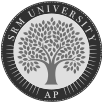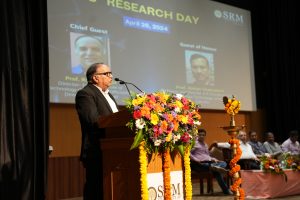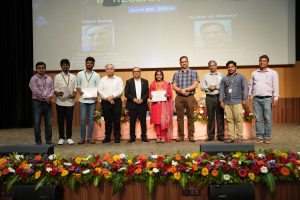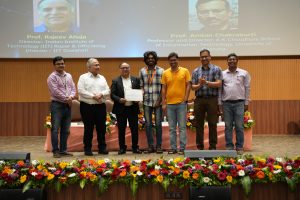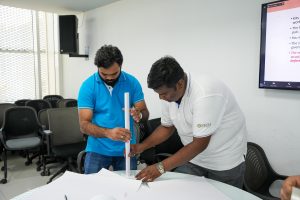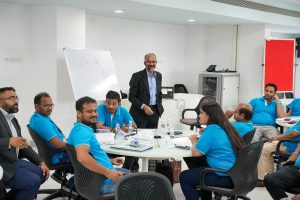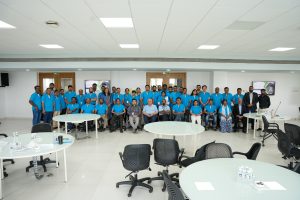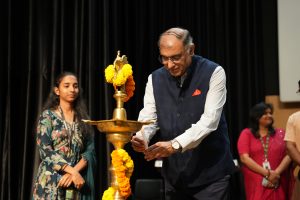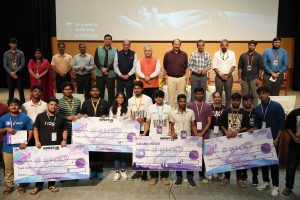Critical Analysis of the Influence of Hydroclimatic Variability and Anthropocene on the Groundwater of the Sundarbans
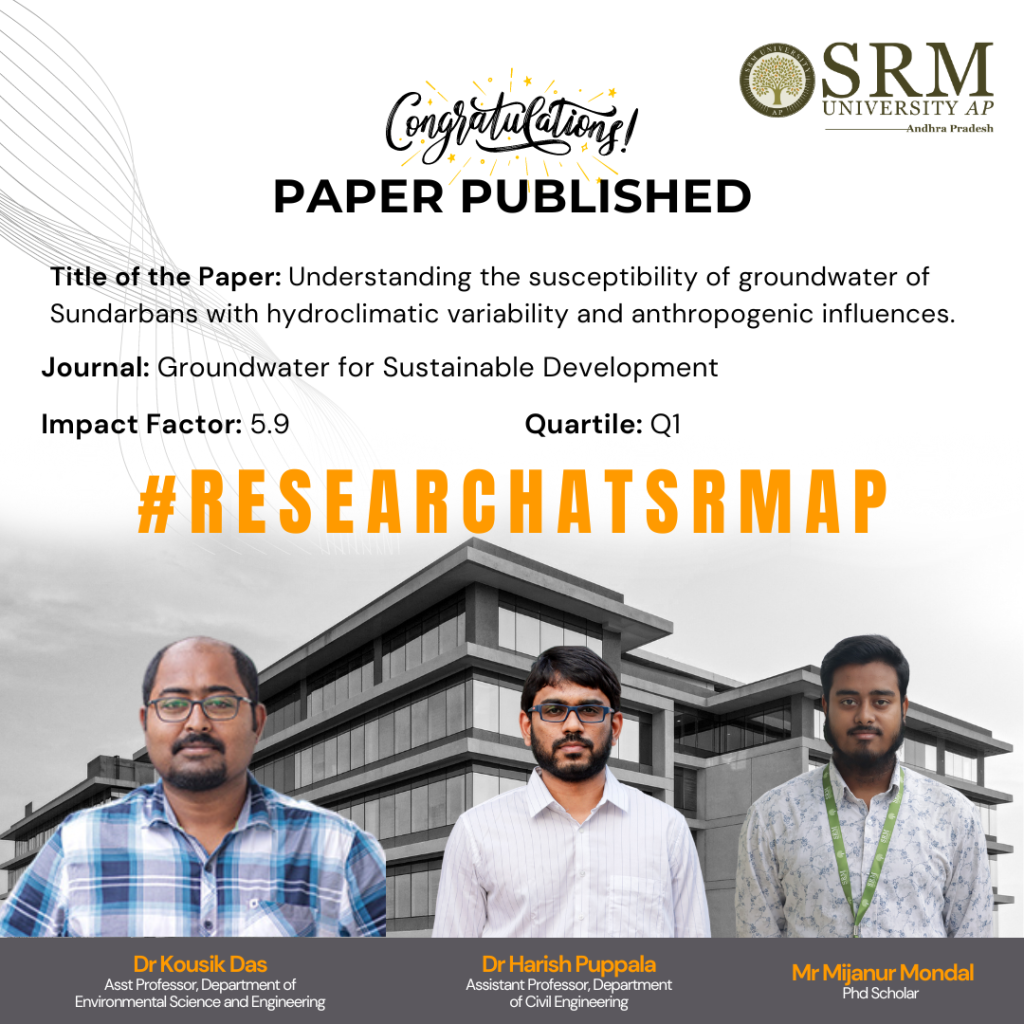
The water crisis in India, especially in the coastal regions, has worsened alarmingly, coercing environmentalists and researchers to critically study the reason behind this phenomenon. The Sundarbans region faces a scarcity of drinking water in terms of quality and quantity due to various reasons. Dr Kousik Das, Asst. Professor, Department of Environmental Science and Engineering, Dr Harish Puppala, Asst Professor, Department of Civil Engineering and Mr Mijanur Mondal, Research Scholar from the Department of Environmental Science and Engineering has conducted a groundbreaking study on the increased salinization of water due to human activities. The research trio has published a paper titled “Understanding the susceptibility of groundwater of Sundarbans with hydroclimatic variability and anthropogenic influences” in the prestigious Q1 journal Groundwater for Sustainable Development, which has an impact factor of 5.9, critically analysing the numerous factors that affect the quality of drinking water in the Sundarbans region.
Abstract
Coastal aquifers worldwide are experiencing increased salinisation due to climate change and human activities. Sundarbans, in India, is one such area where this phenomenon is noticed at an unprecedented rate, making drinking water unpotable for consumption. Existing studies lack a comprehensive analysis of the underlying causes. This study conducts a systematic literature review to identify drivers of groundwater salinisation, examining climate change parameters such as rainfall patterns, sea level rise, El Niño-Southern Oscillation, and tropical cyclones. Significant groundwater level declines from 1996 to 2017 are primarily attributed to variations in the Indian Ocean Dipole and El Niño Southern Oscillation, affecting rainfall and recharge rates. During tropical cyclones, groundwater levels rise rapidly, and quality is sensitive to El Niño Southern Oscillation. Rising sea levels, changing rainfall, and increasing population density worsen salinisation. Shallow aquifers have high salinity, whereas deep aquifers exceed permissible limits. This underscores the urgent need to address drinking water scarcity and potential migration resulting from complex interactions between climate, population, and groundwater management.
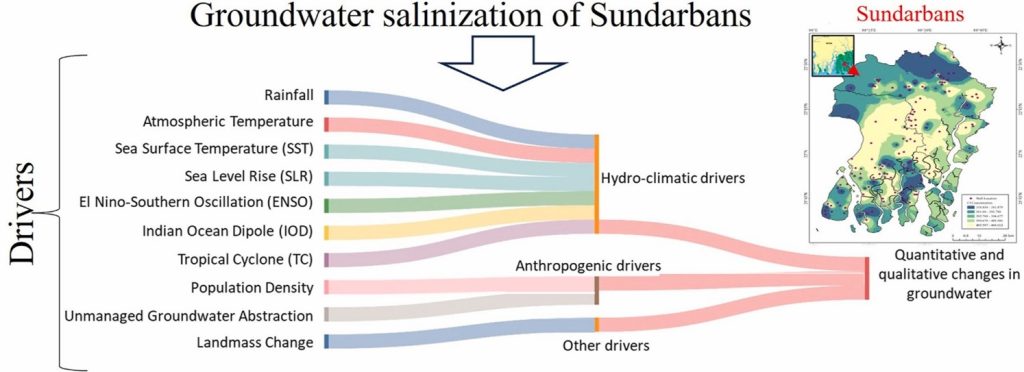
Social Implications of the Research
- Water Quality Monitoring: Implementing regular monitoring of salinity levels in groundwater to ensure compliance with safety standards.
- Community Awareness Programmes: Conducting educational campaigns to inform local communities about the risks of high salinity levels in drinking water and promoting the judicious use of water sources so that unscientific abstraction can be reduced.
- Policy Development: Formulating policies at the local and national levels to regulate salinity levels in drinking water and ensure public health protection.
- Infrastructure Improvement: Investing in water treatment facilities or technologies to remove high salt levels from groundwater sources. Alternative sources and rainwater harvesting can be taken into consideration.
Collaborations – IIT Kharagpur, India
The research team plans to work on Groundwater vulnerability modelling using AI/ML in Sundarbans, India next. The team has begun collecting primary data using questionnaire surveys and interviews to throw light on socio-economic conditions and to understand the core reasons for the water crisis and health and psychological issues due to water unavailability, especially during extreme events like cyclones.
Link to the article
- Published in CIVIL NEWS, Departmental News, ENVS News, News, Research News
Dr Chimoy Das’ Research Makes Latest Breakthrough in Material Science
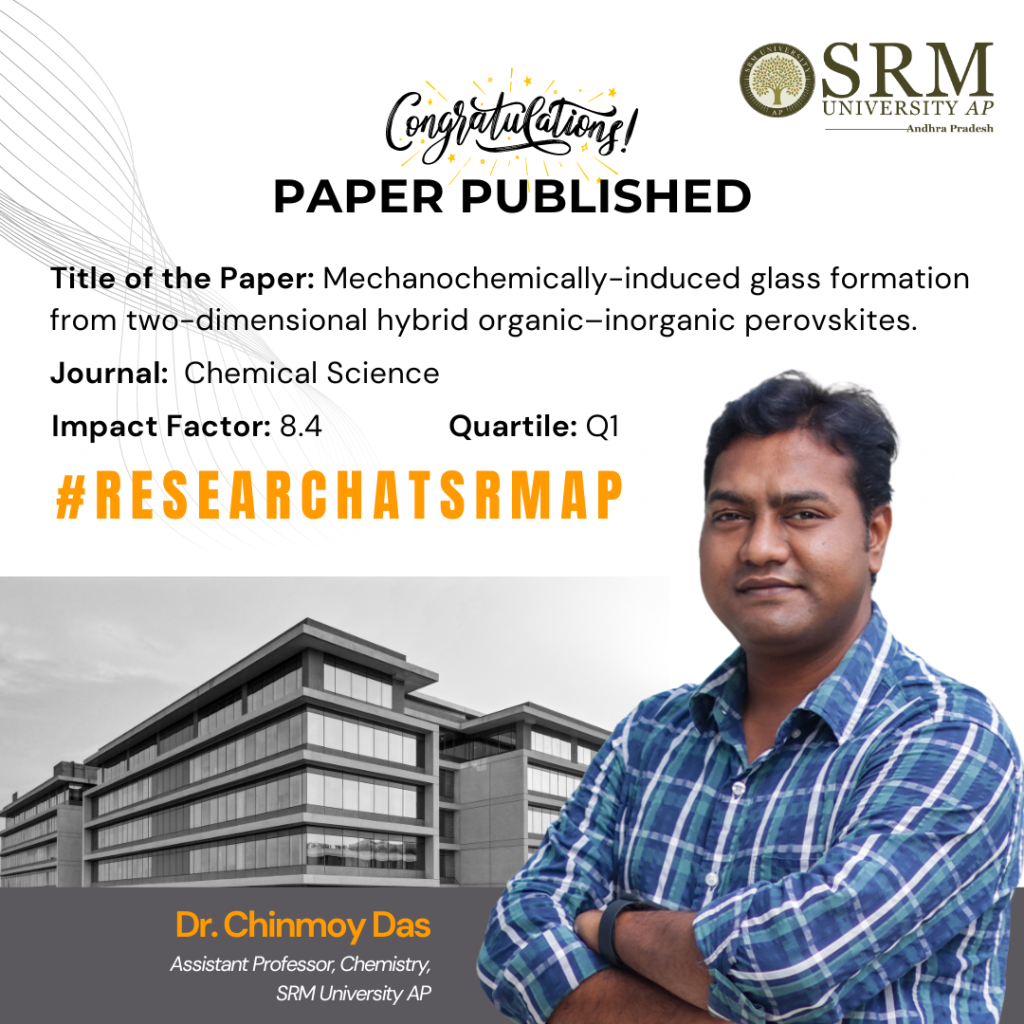
The Department of Chemistry is thrilled to announce the paper “Mechanochemically-induced glass formation from two-dimensional hybrid organic-inorganic perovskites”, published by Dr Chinmoy Das, Assistant Professor in the reputed Q1 Journal Chemical Science with an 8.4 Impact Factor. This groundbreaking research introduces a novel method for transforming crystalline phases into glasses through mechanochemical processes. This environmentally friendly and efficient method opens new doors for manufacturing glasses, revolutionising traditional processes. This remarkable research celebrates this extraordinary blend of chemistry, physics, and innovation!
Abstract
The first mechanochemically-induced hybrid organic-inorganic perovskites (HOIPs) crystal-to-glass transformation was reported as a quick, environmentally friendly, and productive method of making glasses. Within ten minutes of mechanical ball milling, the crystalline phase transformed into the amorphous phase, demonstrating glass transition behaviour as shown by thermal analysis methods. The microstructural evolution of amorphization was studied using time-resolved in situ ball-milling with synchrotron powder diffraction. The results indicated that energy may accumulate as crystal defects because the crystallite size reaches a comminution limit before the amorphization process is finished. The limited short-range order of amorphous HOIPs was discovered through total scattering experiments, and photoluminescence (PL) and ultraviolet-visible (UV-vis) spectroscopy were used to examine their optical characteristics.
Explanation of the research in layperson’s terms
Crystalline inorganic perovskites (general chemical formula is ABX3, where A and B are cations, and X is anion) are generally known for their unique optoelectronic applications, such as solar cells, photodetectors, and LEDs (light emitting diodes). In this research, Dr Das revealed hybrid materials comprised of organic linkers and inorganic nodes, which constitute hybrid organic-inorganic perovskites (HOIPs). The research demonstrated a rapid and environment-friendly (mechanochemically ball milling assisted) synthetic approach to transform the crystalline phase to its non-crystalline/amorphous phase. Interestingly, the amorphous phase of HOIPs showed temperature-dependent glass transition temperature (Tg) at very low temperatures, ~50 C. The structure of the HOIP glasses has been characterised through total-X-ray diffraction studies and pair-distribution functions. The crystalline and glassy HOIPs showed optical properties, which were studied by photoluminescence (PL) and ultraviolet-visible (UV-vis) spectroscopy.
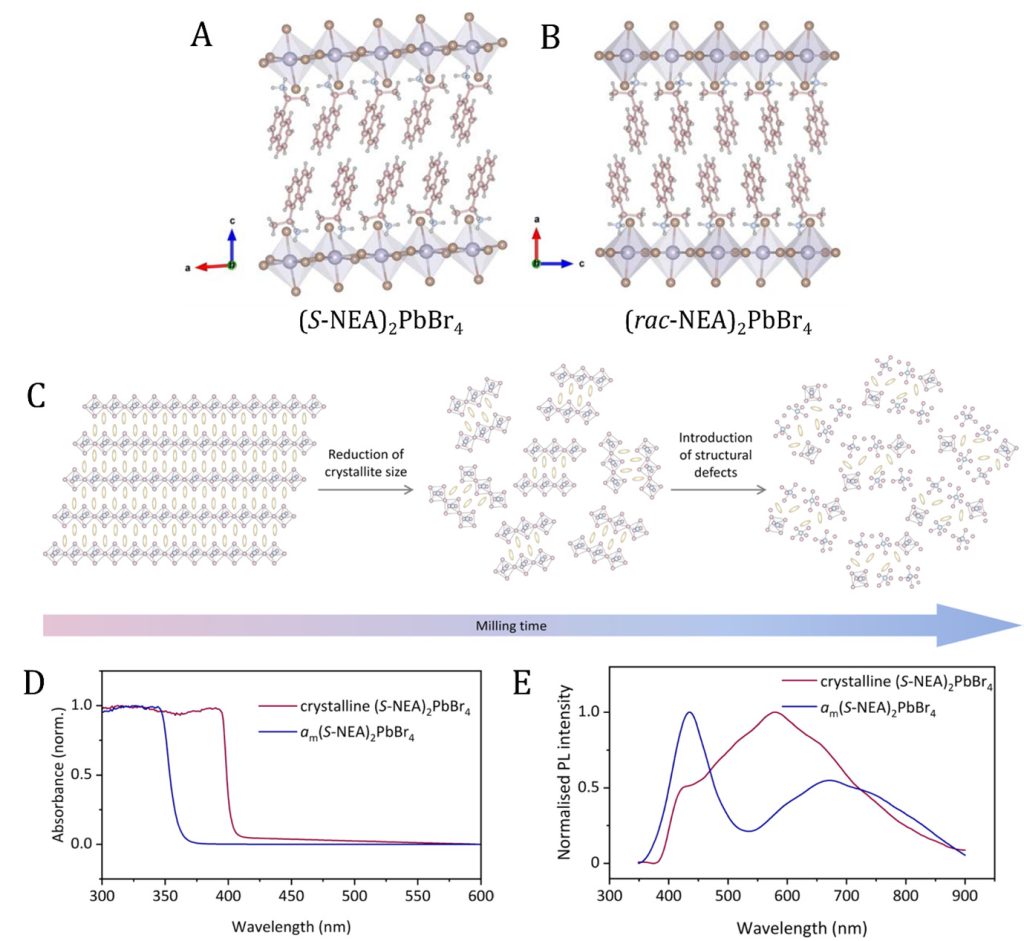
Figure 1. Single crystal structures of (A) (S-NEA)2PbBr4 and (B) (rac-NEA)2PbBr4. Pb, Br, C, N and H atoms are represented by purple, brown, pink, blue, and grey colours, respectively. (C) Schematic illustration of the microstructural evolution on 2D HOIPs upon ball-milling. (D) UV-Vis and (E) photoluminescent properties of crystalline (S-NEA)2PbBr4 (purple) and glassy (S-NEA)2PbBr4 (blue) HOIPs.
Practical implementation/ social implications of your research
Through the mechanochemical approach, we prepared novel hybrid organic-inorganic perovskite (HOIP) glasses within ten minutes, showing the greater feasibility of processing the glass material for industrial implication. On the other hand, we also demonstrated that the HOIP glasses showed photoluminescence properties, which would enable us to fabricate the device for solar cells, photodetectors, LEDs and many more.
Collaborations
- Department of Materials Science and Metallurgy, University of Cambridge, United Kingdom.
The Department of Chemistry has established a research group at SRM University-AP, and the group has started to explore an emergent research area of crystal-glass composite materials towards the applications of atmospheric water harvesting, solid-state electrolytes, photovoltaics, and conversion of gaseous Carbon-dioxide molecules to industrially relevant liquids, such as methanol or ethanol.
Any interested candidate can reach out to Dr Chinmoy for exciting projects.
- Published in Chemistry-news, Departmental News, News, Research News
Field Visit: Biological Sciences Students at AIIMS Mangalagiri
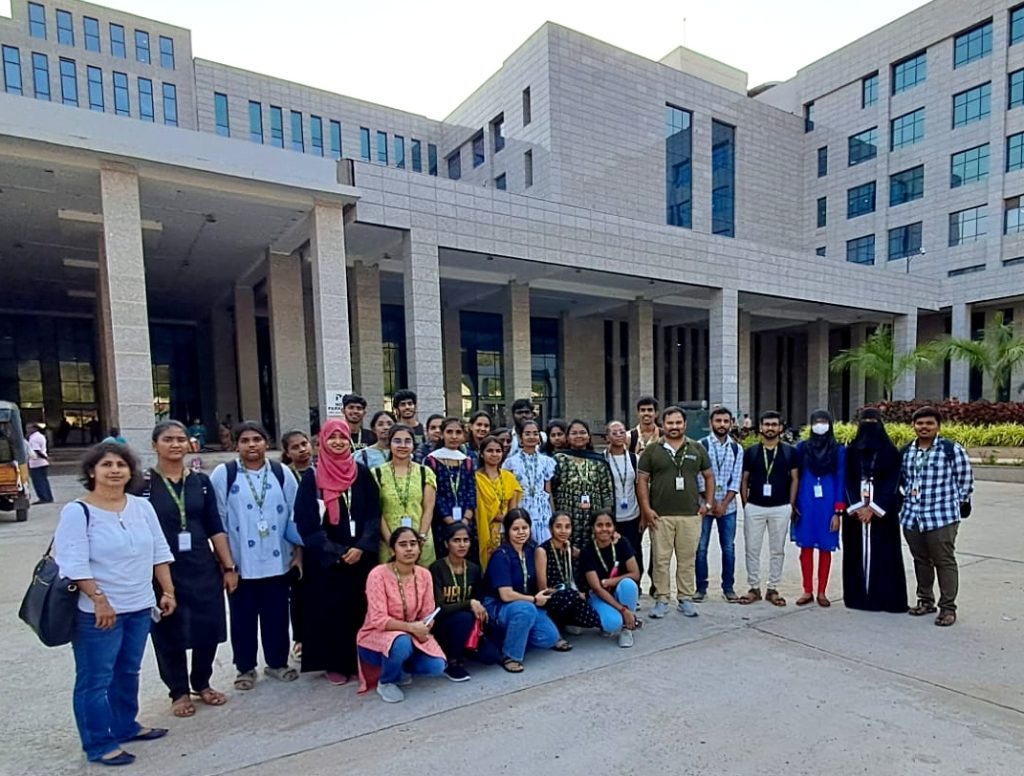
In a significant stride towards enriching their academic experience, students from the Department of Biological Sciences embarked on a captivating field trip to AIIMS Mangalagiri. This excursion served as an integral component of their Active Learning Process, fostering a deeper understanding of real-world applications in the realm of biology. The cohort comprised students from diverse academic backgrounds, including those pursuing 1st year B.Sc in Integrative Biology and M.Sc in Molecular Biology & Biotechnology. Their visit to AIIMS Mangalagiri provided them with a unique opportunity to gain firsthand insights into cutting-edge practices in the field of biomedicine.
During their visit, the students were granted exclusive access to the Integrated Stewardship and OPD Labs, where they were immersed in a world of advanced diagnostics and research methodologies. Expert lectures and demonstrations on state-of-the-art diagnostic techniques such as MALDI-TOF, CBNAAT, CLIA, Vitek, and BactAlert offered invaluable insights into the intricacies of disease detection and monitoring.
This excursion underscored the department’s commitment to fostering a culture of active learning and practical exposure among its students. By exposing them to prominent institutions and industries, such as AIIMS Mangalagiri, students were provided with hands-on training and the opportunity to engage with leading experts in the field.
Accompanying the students were esteemed faculty members of the department, including Dr Sutharsan Govindarajan, Dr Sudeshna Saha, and Dr Prateek Gupta, whose guidance and mentorship further enriched the learning experience.
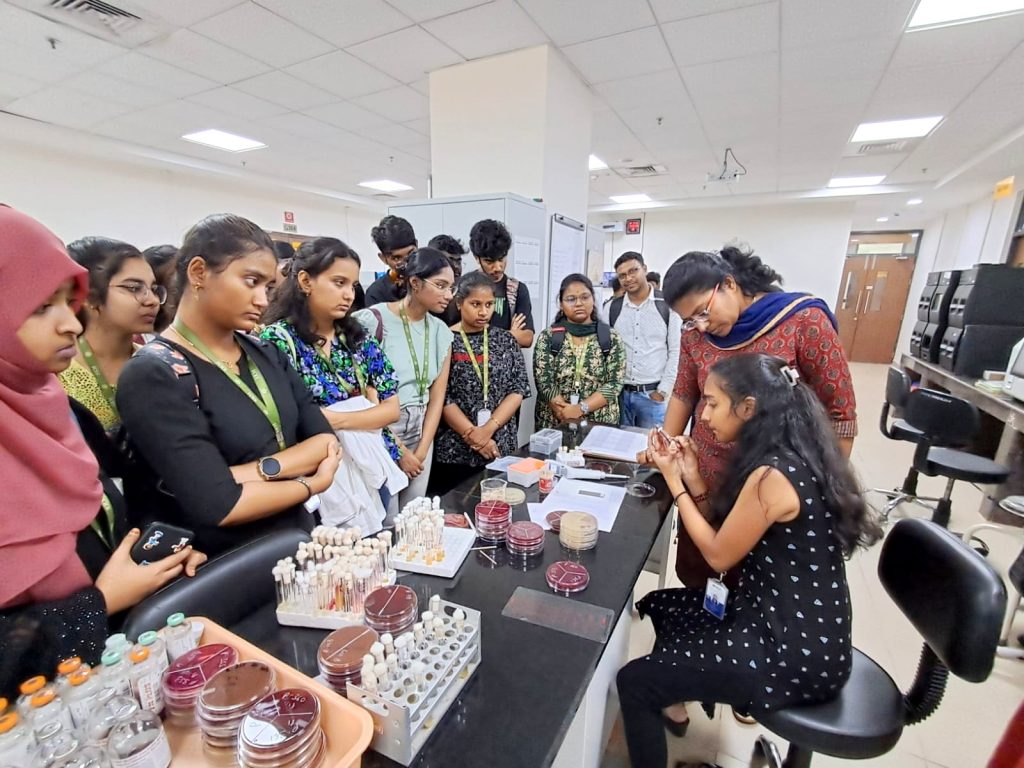
Furthermore, the collaborative efforts between the faculty of SRM University-AP and researchers at AIIMS Mangalagiri were highlighted during the visit. These collaborations span various domains, from developing biomedical devices for disease diagnosis to research endeavours in antimicrobial resistance (AMR), early cancer detection, and drug targeting. Such synergies between academia and research institutions present students with unparalleled opportunities to engage in impactful research initiatives and contribute meaningfully to the advancement of scientific knowledge
Overall, the field visit to AIIMS Mangalagiri served as a catalyst for academic excellence and professional growth, empowering students with the skills, knowledge, and networks necessary to thrive in the dynamic field of biological sciences.
- Published in Biology News, Departmental News, News
Creating History: A Chase to Mt. Everest!
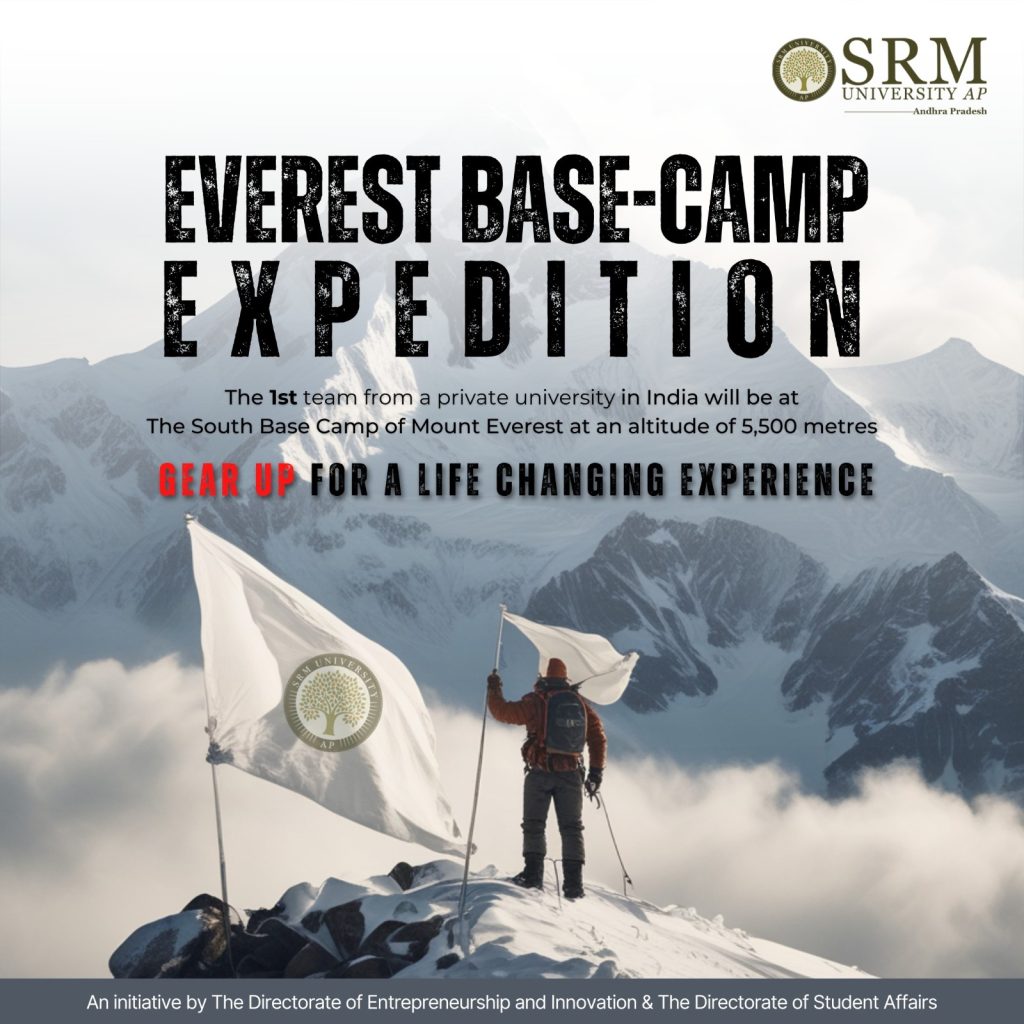
SRM University-AP is gearing up for the ultimate thrill-seeking escapade, which will have hearts racing and adrenaline pumping like never before! The Directorate of Entrepreneurship & Innovation and the Directorate of Student Affairs jointly organise the “Everest Base Camp Expedition”, the mother of all adventures – a daring conquest of the Earth’s highest mountain above sea level – Mount Everest!
The 15-day exhilarating journey will take flight with a maiden batch of 20 young adventurers selected through a rigorous physical and mental ability test on October 11, 2024 (tentative). 4 months of extensive training will commence in full swing, with the selected students pushing their limits and testing their endurance, moulding them into a complete voyager. Various training and practice trips have been scheduled to Arakku Valley to test their strength, Mangalagiri temple for elevation trekking training and much more.
This is a first-of-its-kind initiative by a university in India, presenting a unique opportunity for every enthusiastic explorer to witness the magnificence of the cold, icy peaks of the Himalayas. In addition to providing students with exemplary academic, research and entrepreneurial resources, SRM AP also emphasises the significance of 21st-century skills in nurturing them into socially aware and ethical citizens of tomorrow. This one-of-a-kind trip will ensure that students imbibe the value of belief and courage to instil purpose or a greater aim for anything that they might pursue in life, the importance of not losing faith during hard times and overcoming the obstacles that hinder your aim, the significance of camaraderie and teamwork, to develop essential leadership skills etc.

Students and their mentors have already begun their footsteps on a journey that will transform their lives! Embracing the thrill, embracing the adventure!
This journey will undoubtedly etch unforgettable memories into the fabric of their existence!
- Published in Departmental News, IDEA NEWS, News, student affairs news
8th Research Day: A Pathway to Research and Innovation
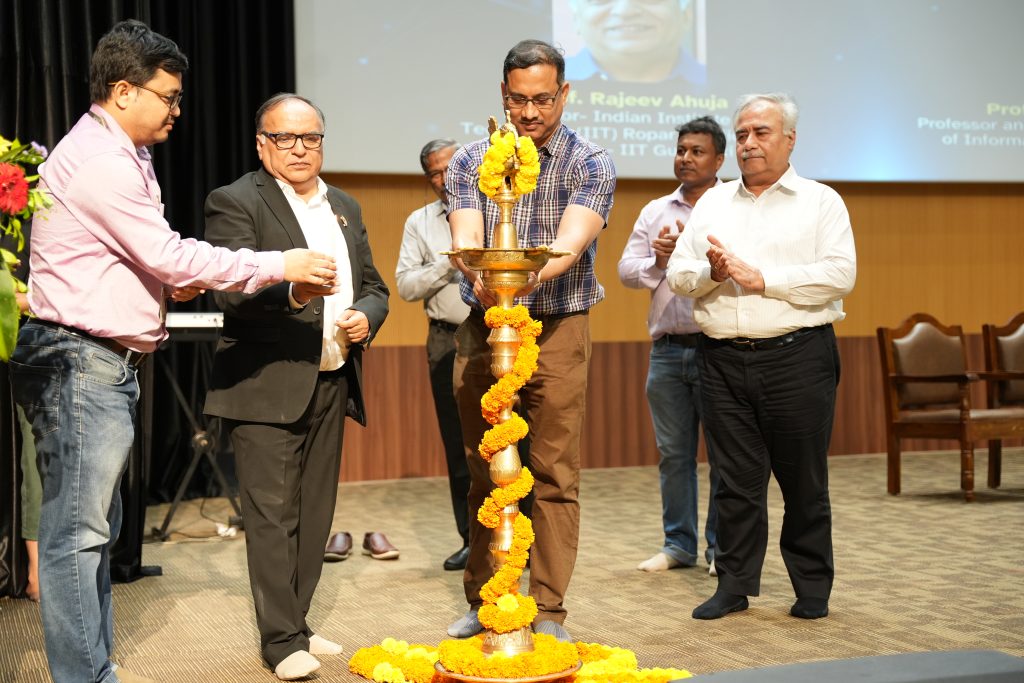
“Research is a passion. We must lay a strong foundation of basic research to further develop, grow and produce a high-quality research output. Focus on translational research as it is the way forward for an innovative world,” said Prof. Rajeev Ahuja, Chief Guest of the 8th Research Day, while addressing the research community of SRM University-AP.
The university hosted the 8th Research Day on April 26, 2024, in the august presence of Chief Guest Prof. Rajeev Ahuja, Director-IIT Ropar and Officiating Director-IIT Guwahati, Guest of Honour Prof. Amlan Chakrabarti, Director–A. K. Choudhury School of Information Technology, University of Calcutta; Vice Chancellor Prof. Manoj K Arora, Registrar Dr R Premkumar, Dean-Research Prof. Ranjit Thapa, Deans of all schools, faculty, research scholars and students. “Research Day at SRM AP is the celebration of our students’ innovative thought and applauding them in their developing research acumen”, remarked Prof. Arora in his welcome address. He encouraged students to take their research to the next level and become entrepreneurs who will transform the Indian market and economy.
Prof. Amlan Chakrabarti, the designated guest of honour for the day, tremendously appreciated the efforts put forth by the SRM AP in propelling a research-centric education. He remarked that research is the pursuit of thought and the product of innovation. Prof. Chakrabarti also delivered distinguished lectures on the intriguing realm of quantum machine learning and exploring generative AI, shedding light on the latest advancements and potential applications in both fields.
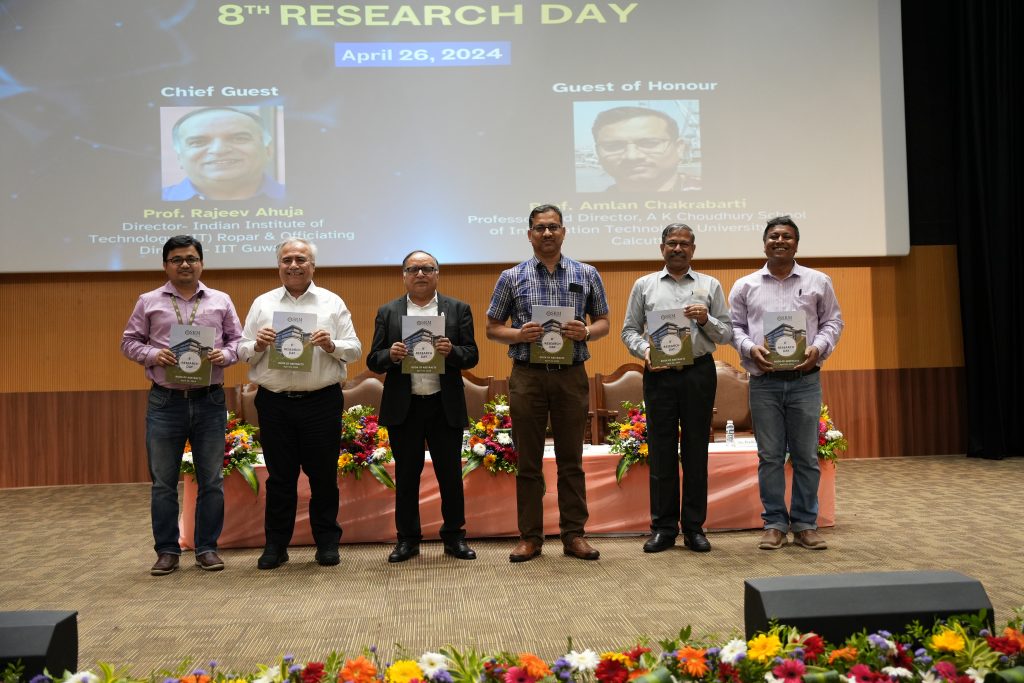
The 8th Research Day was commemorated to celebrate research and innovation in the emerging fields of science, technology, humanities, social sciences, management and commerce. 350+ research abstracts were submitted by undergraduate/postgraduate students and research scholars from across the country, which were culminated and unveiled as an Abstract Book. Selected papers were presented, and medals were awarded to the winners. The paper presentation witnessed 27 participants bagging gold medals and 7 participants securing silver medals. Five esteemed faculty of the university, Dr K M Divya Chaturvedi, Dr Mahesh Kumar Ravva, Prof. G S Vinod Kumar, Dr Ghanshyam Pandey and Dr Ramanjeya Reddy Udumula, were awarded prestigious awards for their stellar contributions and ingenious inventions in their respective domains.
The dignified guests of the events were presented with mementos as a token of gratitude by the university leaders, Dean-Research Prof. Ranjit Thapa and Convenor of the 8th Research Day, Dr Pradyut Kumar Sanki, Associate Professor, Department of Electronics and Communication Engineering. Dr R Premkumar delivered the Vote of Thanks, concluding the spectacular event.
Ranked Third among all private universities in India for two consecutive years according to Nature Index Ranking, SRM University-AP has a total of 2040+ research publications, 200 published patents, 24 granted patents, 43 Nature Index publications and a total outlay of Rs. 37+ crores in projects. The research environment is anchored by Eight Interdisciplinary Research Centres of Excellence. Research Day is a testament to the varsity’s commitment to building a strong research culture and research capacity among the faculty and students across different domains.
- Published in News, Research News
Accelerated Academic Leadership Workshop
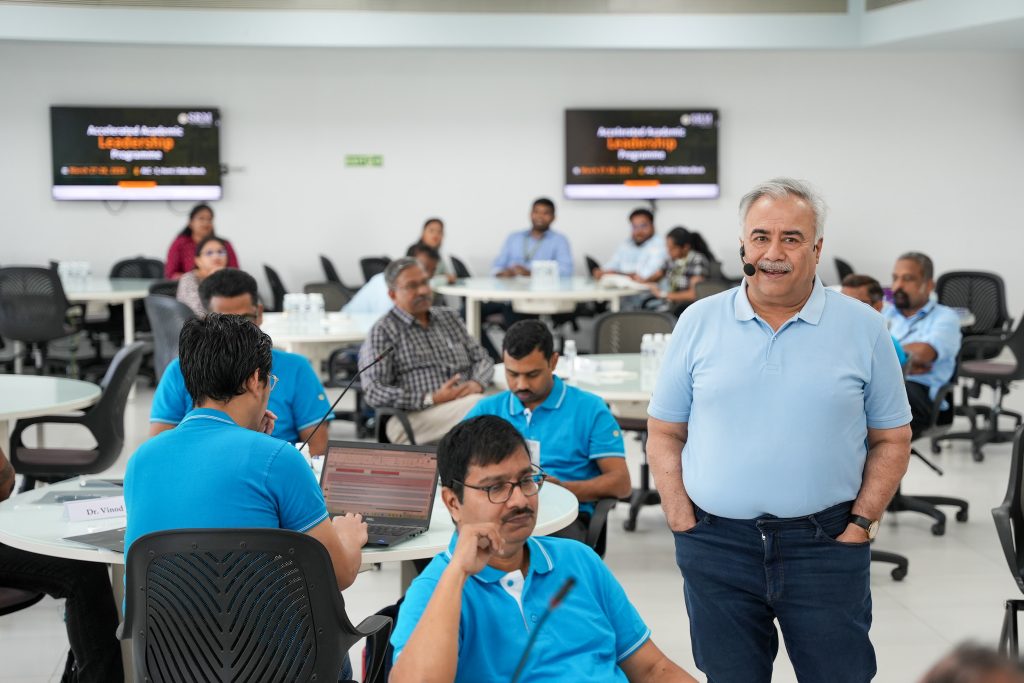
The Directorate of Human Resources organised a 2-day Accelerated Academic Leadership Programme 2024, on March 27 and 28, 2024, bringing together the academic community to align with the institute’s mission and strategic goals. This landmark event, organised in collaboration with People Business Consulting, has brought together Mr Kadapa Hanumantha Rao Muralidhar and Vinish Soman from People Business Consulting, Vice Chancellor Prof. Manoj K Arora, Registrar Dr R Premkumar R, Deans and Associate Deans of all schools and HoDs and faculty from all departments.
“Building on the foundation set by last year’s Alignment 360 Workshop, we are focused on achieving our strategic objectives for 2023-28. Our aim is not only to enhance operational excellence but also to foster individual and collective growth within our community of over 7,000 students and 300 faculty members. Our ambitious targets are to position SRM University-AP among the Top 30 universities in India by 2027-28. We are setting benchmarks that reflect our commitment to excellence and the development of our academic team,” said Prof. Manoj Arora.
Prof. Arora also commented on how the university is dedicated to nurturing a vibrant team of young professors, with an average age of 34, signifying the university’s belief in youthful innovation and dynamic leadership. He also spoke exclusively on SRM AP’s culture of continuous learning and growth, guided by 6 core values integral to our institutional ethos.
- Published in Departmental News, News, Workshop
Leading the Next Generation of Creators and Innovators: Inauguration of Tech Fest 2024
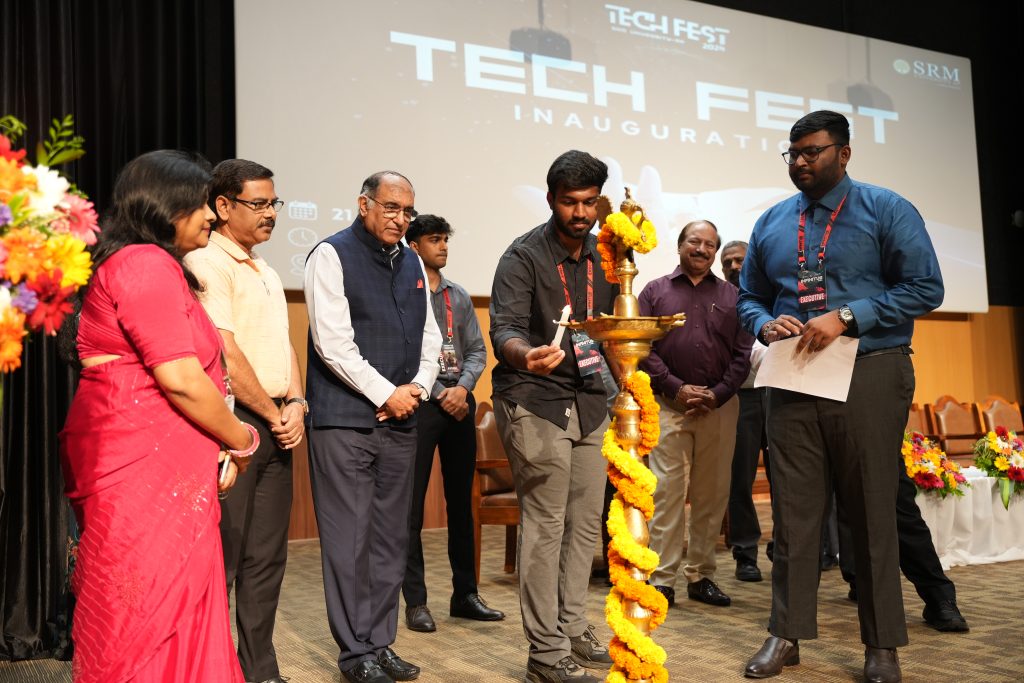
“Tech fests are your platform to explore, learn and thrive. Your spirit to compete and succeed is immaterial without learning, ” remarked Mr Sanjiv Bhavnani, distinguished guest at SRM University-AP Tech Fest 2024.
SRM University-AP kick starts its Tech Fest with glamour, zeal and endless exuberance. The student-led national fest, held from March 21-22, 2024, was inaugurated in the gracious presence of Guest of Honour, Mr Dinesh Dua, Executive Director on Board at Nectar Lifesciences Limited, esteemed guests, Mr Sanjiv Bhavnani, founder of Mentorpreneur & Infotecniques and Dr Deepak Pandit, Chair Professor – Innovation and Entrepreneurship, BML Munjal University, Vice Chancellor, Prof. Manoj K Arora, Registrar, Dr R Premkumar, Director-Student Affairs, Mr Anil Kumar Nigam, Chief Club Advisor, Dr Priyanka, Deans of different schools, leaders and representatives from the Student Council, and all students of the varsity.
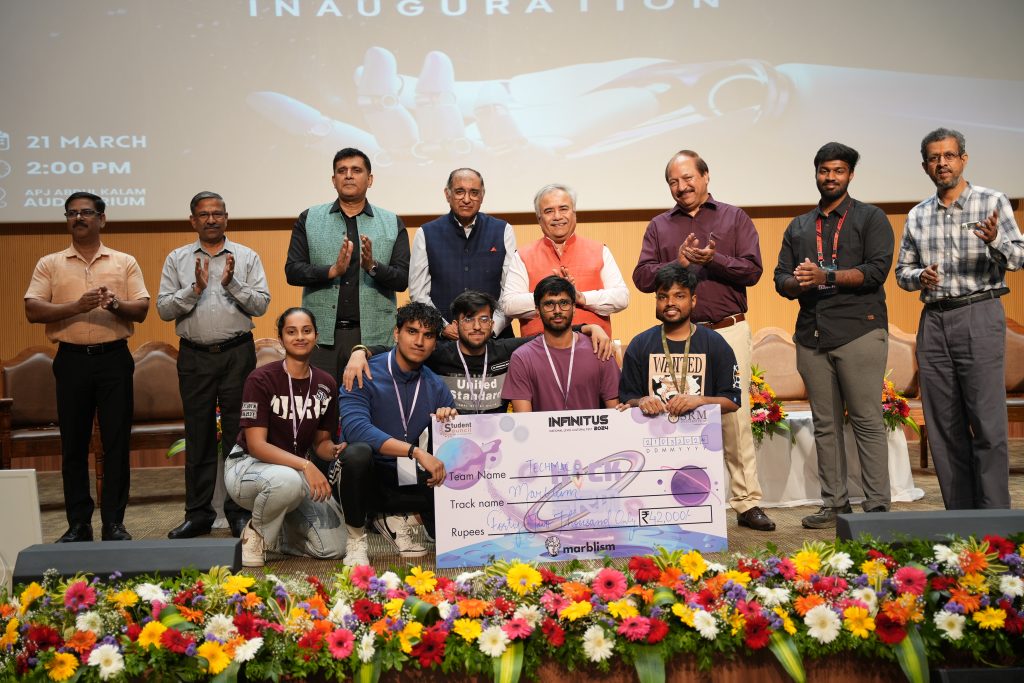
Vice Chancellor, Prof. Manoj K Arora stated in his welcome address that technical fests are magnificent learning platforms. He said, “This is your opportunity to collaborate, network and learn 21st-century skills such as creativity, critical thinking, and problem-solving leadership that will equip you to be the tech leaders of tomorrow.” Mr Dinesh Dua, Guest of Honour, encouraged budding students to take advantage of the upsurge of technology to recalibrate themselves to the new age of intelligence. He expressed his genuine delight in inaugurating the Tech Fest with an interactive discourse on Artificial Intelligence.
The thrilling university fest embarked on its two days of electrifying events and activities with a mega Hackathon challenge, “Hack SRM”, with a prize pool of Rs 4 Lakhs. The 24-hour hackathon challenge saw dynamic participation from colleges around the nation, with young techies from VIT-AP, Amrita Vishwa Vidyapeetham-Amaravati, SRM University Ramapuram, VISAT Maharashtra bagging the top prizes worth Rs 5000/-, Rs 10,000/-, Rs 40,000/- and Rs 50,000/-.
Tech Fest 2024 is the university’s testament to celebrating innovation, creativity, and boundless possibilities. The four-day fest features technical competitions, non-technical events, workshops, hackathons, ideathons and expos on every technology domain enhancing students’ learning experience.
- Published in News, student affairs news
Breakthrough in Lead-Free Brass Manufacturing: Patent Granted to Prof. G. S. Vinod Kumar
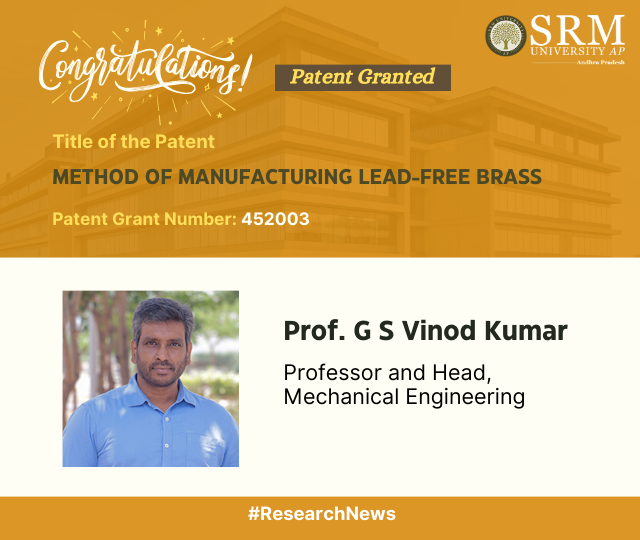
The Department of Mechanical Engineering are excited to share a significant milestone achieved in the field of material science and metallurgy. Prof. G S Vinod Kumar, Professor and Head of the Department, has been granted a patent jointly with Titan Company, Bangalore, for the invention “METHOD OF MANUFACTURING LEAD-FREE BRASS” (Patent Grant Number: 452003). This industrial patent was created through a collaboration between SRM University-AP and Titan Company Limited.
This groundbreaking discovery not only transforms the manufacturing of lead-free brass, but it also highlights the collaborative spirit that drives advances in materials engineering.
Abstract
The present disclosure relates to a field of material science and metallurgy. In particular, the present disclosure discloses a method for manufacturing lead-free brass alloy. The method includes preparation of first master alloy by melting copper and a transition element, and a second master alloy by mixing molten zinc and molten copper. The lead-free brass is obtained by meting a predetermined proportion of the first master alloy and second master alloy along with elemental copper in a furnace under an argon atmosphere. The lead-free brass alloy is then subjected to a precipitation hardening process to improve hardness. The lead-free hard brass alloy containing titanium exhibits improved hardness in comparison to bare lead-free brass mainly due to the presence of intermetallic nanoscale precipitates, which are distributed throughout the lead-free brass matrix.
SRM University-AP continues pushing the limits of scientific discovery and industrial innovation.
- Published in Departmental News, Mechanical Engineering NEWS, News, Research News
Deep Transfer Learning for Green Environment Security in Smart Cities

The Department of Computer Science and Engineering is pleased to announce an extraordinary research paper titled “A Deep Transfer Learning Model for Green Environment Security Analysis in Smart City“, authored by Dr Sambit Kumar Mishra, Assistant Professor, was published in the Journal of King Saud University – Computer and Information Sciences that falls within the Q1 quartile with an Impact Factor (IF) of 6.9. The study introduces a model to automatically classify high-resolution scene images for environmental conservation in smart cities. By enhancing the training dataset with spatial patterns, the model improves green resource management and personalised services. It also demonstrates the effectiveness of LULC classification in smart city environments using transfer learning. Data augmentation techniques improve model performance, and optimisation methods enhance efficiency, contributing to better environmental management.
Abstract
The research addresses the importance of green environmental security in smart cities and proposes a morphologically augmented fine-tuned DenseNet121 (MAFDN) model for Land Use and Land Cover (LULC) classification. This model aims to automate the categorisation of high spatial resolution scene images to facilitate green resource management and personalised services.
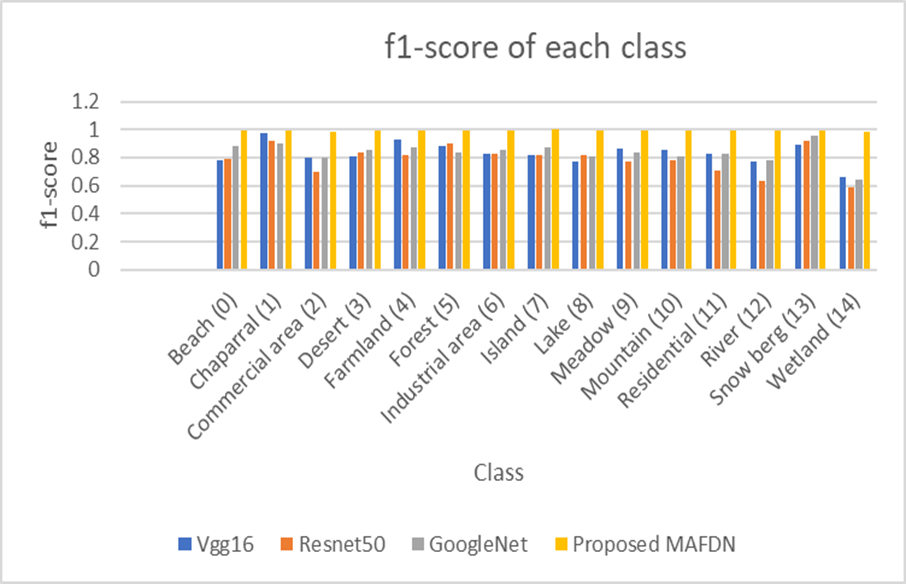
Dr Mishra collaborated with Dr Rasmita Dash and Madhusmita Sahu from SoA Deemed to be University, India, as well as Mamoona Humayun, Majed Alfayad, and Mohammed Assiri from universities in Saudi Arabia.
His plans include optimising the model using pruning methods to create lightweight scene classification models for resolving challenges in LULC datasets.
- Published in CSE NEWS, Departmental News, News
Tracing a Translator’s Journey: An Interview with V Ramaswamy
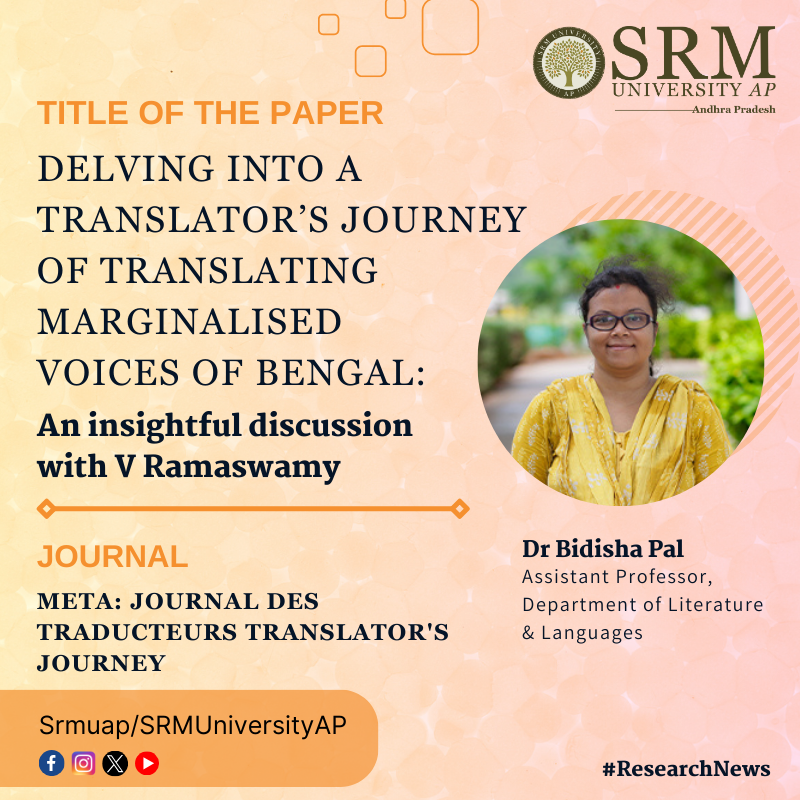
A translated work must retain the essence and flavour of regional culture and locales. A good translator tries to reproduce the particularities that are ingrained within the texts. On this note, Dr Bidisha Pal, Assistant Professor from the Department of Literature and Languages, has published a paper, “Delving into a Translator’s Journey of Translating Marginalised Voices of Bengal: An Insightful Discussion with V Ramaswamy” in Meta Journal des traducteurs Translators’ Journal. This research revolves around a discussion with the well-known translator V Ramaswamy, a noted name in Bengali Dalit literature and translation. Ramaswamy shares his thoughts on working on the translation projects that he enjoys doing and that establish the cause of the marginalised people of Bengal.
Abstract
In this interview discussion with Bidisha Pal and Md. Mojibur Rahman, translator V Ramaswamy focuses on the journey of his translation and tryst with the marginalised Dalit voice(s) in Bengal. He speaks about the writings that propel him to choose translating and to carry voice(s) beyond the Bengal arena, thus dissolving language barriers. The deliberate choice to translate various pieces representing various periods acts as a witness to his existence as an independent translator. According to him, translation is also a source of healing to deal with a tragic past and the complicacies that life often presents to him. He shares his experience translating Subimal Mishra, the powerful poet who speaks for marginalised people. Ramaswamy, as he states in the interview, makes a vow to translate Mishra’s whole writing career. He talks about translating Manoranjan Byapari, a Bengali Dalit prize-winning author and political persona who has also championed the Dalit cause in Bengal, Adhir Biswas, the story-writer and publisher of a publishing house in Kolkata Gangchil that publishes writings by those literary personas who do not fall, as such, into the category of the mainstream, Bangladeshi writer Shahidul Zahir whose revolutionary voice and zeal reverberate in the literary world of Bangladesh, as well as Ansaruddin, a writer and farmer by profession whose works Ramaswamy is currently translating. Despite not being a part of the literary world, Ramaswamy has built an intense connection with literature and has gradually become part of the world. For him, translation is something that has to remain faithful to the source text, especially if people are doing literary translation.
Practical implementation/social implications of the research
The research contains elements that are connected with the values of the society. It discusses the nuances of translation of the writings of marginalised people, which contain many unforeseen truths of society, and depicts the struggles for the existence of the people. The translator is doing a commendable job compiling the writing thorough translation that will act as a bridge to the unfamiliar audience who could feel connected with the marginalised people.
Dr Bidisha aims to publish many more articles in the diverse interdisciplinary fields of literature, edit books, and attend conferences.
- Published in Departmental News, English Current Happenings, English news, News, Research News

